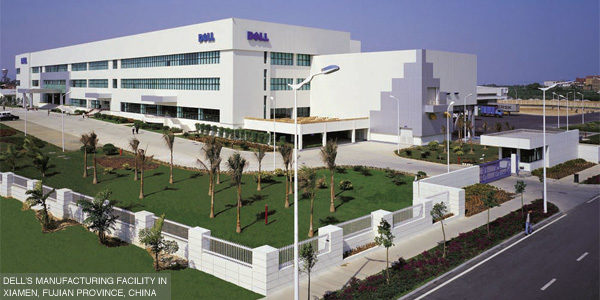Inside Dell's global command centers

When a manufacturer sells its products worldwide, its customers expect that it will also service those products on a global scale. It's not easy to meet those expectations in a consistent and timely way. But thanks to "global command centers" that oversee delivery of parts and field service, the technology giant Dell Inc. is able to ensure that its enterprise customers worldwide get the service they need when they need it.
A global command center provides companies with visibility that allows them to monitor supply chain activities and make adjustments in real time as events occur. Although command centers are a relatively new supply chain initiative for many companies, Dell opened its first one nearly 10 years ago for service parts. (Dell also operates several command centers on the fulfillment side.)
Dell, based in Round Rock, Texas, makes and sells personal computers, servers, data storage devices, network switches, and computer peripherals. The company outsources much of its on-site technical support for those products to outside field engineers; it also contracts with third-party logistics companies to handle the storage and delivery of service parts to customers.
Adopting the command-center concept for parts and service delivery has helped Dell work more closely with its service providers and be more proactive when it comes to customer service, thereby strengthening customer loyalty. A peek inside one of the command centers shows how they work and why they've been successful.
Dell's command centers are located in Austin, Texas; Limerick, Ireland; Kawasaki, Japan; Xiamen, China; and Penang, Malaysia. According to the technology giant, these customer-focused command centers provide:
- Critical situation procedures for analyzing and recommending solutions during major crises
- Critical management teams that include Dell experts and experts from partners such as Microsoft, Oracle, and Veritas
- Mapping programs that may be used even during a natural disaster, power outage, or virus attack to efficiently mobilize and route emergency resources
- Real-time tracking for management of incidents, technicians, and service parts
- Live news and weather feeds to proactively identify national problems that might cause customer service delays
Source: Dell Inc.
ALIGNING WITH CUSTOMERS' PRIORITIES
Dell reported $61.5 billion in revenue from its operations in 2011, one of the most successful years in the company's history. The bulk of that revenue derives from product sales, but after-sale support plays an important role, as service quality has become crucial for maintaining customer loyalty.
"In the last decade, the perception of [information technology] for many customers began to shift from being viewed as just a cost center to being viewed as a key strategic advantage," explains Steve Sturr, executive director of global services at Dell. "Customers expected faster response and resolution times from their vendors in order to assure the continuity of critical business processes and to manage costs. It was imperative for Dell to acknowledge the changing customer needs and align our support model appropriately. The global command centers were born from this evolution in customer priorities."
Dell's service parts command centers are located in Austin, Texas; Limerick, Ireland; Kawasaki, Japan; Xiamen, China; and Penang, Malaysia. At each center, experts in various subject areas closely monitor service developments and direct Dell's service providers. The command center in Austin, for example, resembles a "war room" staffed with experts who sit at computer consoles arranged auditorium-style, so they can see an array of huge wall-mounted screens displaying service requests, maps, news, weather, and other live information feeds. "It looks like a NASA command center," says Sturr.
The five command centers' staffers monitor service requests from customers. In addition to offering assistance over the telephone, they route spare parts from more than 600 parts depots across the globe and dispatch technicians to a customer's site if needed. The centers, in turn, are supported by 30,000 technical experts worldwide, who provide tech support to customers and the field engineers who perform on-site repairs.
Given businesses' dependence on information technology, Dell's customers often need help right away. If the Austin troubleshooters, for instance, can't resolve the customer's problem over the phone, they can arrange the delivery of parts and dispatch of a technician, often within two hours.
A CLEAR VIEW IN REAL TIME
Real-time supply chain visibility plays a key role in ensuring Dell's ability to respond quickly to customers' requests. The display of real-time information on the computer monitors and screens is enabled by Dell's custom-designed technology platform, called Clear View monitoring. That platform allows Dell to monitor service dispatch activity as it occurs.
Clear View monitoring is actually a combination of business-process management software and business-activity monitoring software. Together, these applications take data feeds from Dell's partners and the company's own internal systems, and then run the data through a rules engine, which has preset conditions to flag a command-center staffer about when to act on an issue. The rules engine software can detect simple exceptions in a single customer service request or recognize complex patterns emerging from multiple requests. "It establishes thresholds for when there's a problem," Sturr says.
The Clear View platform interfaces with a geographical data system. That makes it possible for the system to match a service dispatch with the optimal parts location in Dell's supply chain network. It can also take into account current weather information to determine whether an event like a storm might affect a parts shipment. The command centers also evaluate the potential impact on parts deliveries of flight delays, traffic congestion, local events, and news developments, and help customers develop contingency plans.
Because the center is monitoring weather developments, Dell can, for example, forewarn a customer of an impending storm and advise precautions. Sturr cites the example of a tornado ripping through part of the U.S. Midwest. Dell could contact a hospital in that area about setting up a command center of its own to track health information for patients who are injured by the tornado. To assist the hospital during that emergency, Dell could pull computers off its factory floor and fly those machines and a team of engineers to the hospital to set them up.
To coordinate emergency response, Dell would have to work with its network of third-party service providers. The command center plays a key role in scenarios like this one and other, everyday events because it enables data integration between Dell's information systems and those of its service partners. That's critical, Sturr says. "When you operate a heavily outsourced facility, you want visibility into what happens inside your partners' [operations]."
There must also be flawless exchanges of information when multiple parties are involved in providing service, often in extremely short order. "There have to be real-time data feeds to make command centers work," says Sturr.
PROACTIVE SUPPORT
The global command centers have enhanced Dell's customer service in a number of ways. For one thing, they enable a swifter response to customers' service needs. For another, they help to ensure that routine service calls and emergencies alike are addressed through the most effective processes. In fact, Sturr says, Dell sees the command centers as centralizing "a process-assurance capability that acts as a day-to-day process-orchestration engine." The centers' expertise has also allowed Dell to better prepare and mobilize information technology resources to support large-scale customer events such as political summits and sports competitions.
More importantly, perhaps, is that the command centers make it possible for Dell to reach out and help customers prepare for disruptions, delays, and other problems that are outside the computer maker's control. "When there's a disruption in the supply chain, we can notify customers proactively," says Sturr. "For example, if there's bad weather in the Midwest, parts won't get delivered because planes aren't flying. Customers want to hear from us first and not the next day. Customer communication is the single most important thing we do."
Along with enhanced customer service, the centers have increased supply chain efficiency through better coordination with outside vendors and reduced operational costs in Dell's parts supply operation, thus improving the company's overall competitiveness and profitability.
"We've realized significant improvements in our overall on-time-performance metric, and the process improvements driven from within the global command centers have saved Dell millions of dollars," Sturr says. "But the most unique advantage is the [centers'] ability to work across all the functional segments of our supply chain and act as a mortar that seamlessly unites each of those segments."
This story first appeared in the Quarter 3/2012 edition of CSCMP's Supply Chain Quarterly, a journal of thought leadership for the supply chain management profession and a sister publication to AGiLE Business Media's DC Velocity. Readers can obtain a subscription by joining the Council of Supply Chain Management Professionals (whose membership dues include the Quarterly's subscription fee). Subscriptions are also available to non-members for $34.95 (digital) or $89 a year (print). For more information, visit www.SupplyChainQuarterly.com.
Related Articles

Copyright ©2024. All Rights ReservedDesign, CMS, Hosting & Web Development :: ePublishing